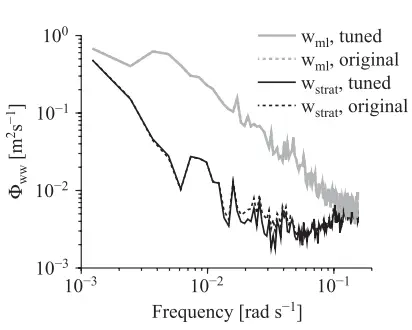 Frequency spectra of vertical water velocity. Profiles from entirely within the mixed layer (black) and the stratified ocean (gray) are shown. Dashed curves of the same color are spectra calculated using the original, untuned flight parameters. Note that the difference is only apparent in the stratified case.
Frequency spectra of vertical water velocity. Profiles from entirely within the mixed layer (black) and the stratified ocean (gray) are shown. Dashed curves of the same color are spectra calculated using the original, untuned flight parameters. Note that the difference is only apparent in the stratified case.Abstract
Vertical velocities in the world’s oceans are typically small, less than 1 cm s−1, posing a significant challenge for observational techniques. Seaglider, an autonomous profiling instrument, can be used to estimate vertical water velocity in the ocean. Using a Seaglider’s flight model and pressure observations, vertical water velocities are estimated along glider trajectories in the Labrador Sea before, during, and after deep convection. Results indicate that vertical velocities in the stratified ocean agree with the theoretical Wentzel–Kramers–Brillouin (WKB) scaling of w; and in the turbulent mixed layer, scale with buoyancy, and wind forcing. It is estimated that accuracy is to within 0.5 cm s−1. Because of uncertainties in the flight model, velocities are poor near the surface and deep apogees, and during extended roll maneuvers. Some of this may be improved by using a dynamic flight model permitting acceleration and by better constraining flight parameters through pilot choices during the mission.